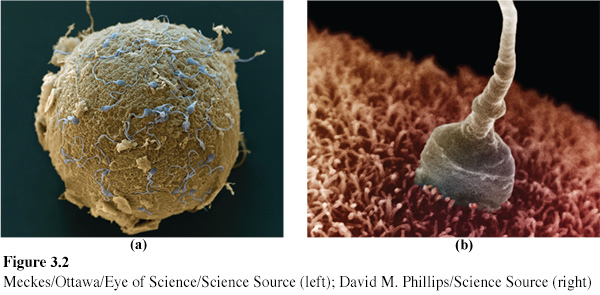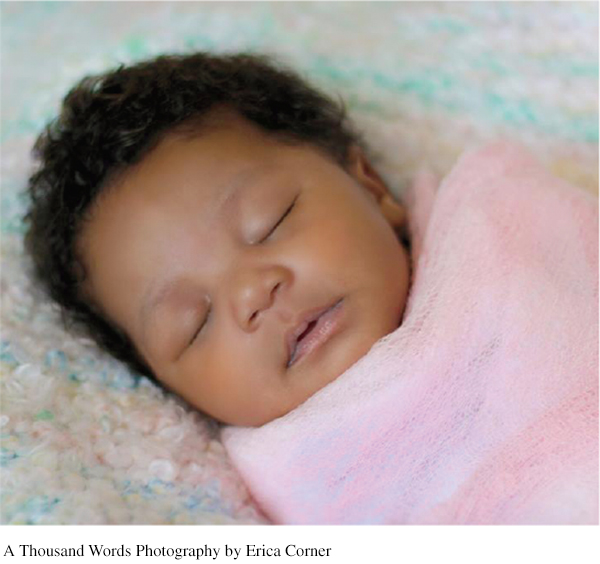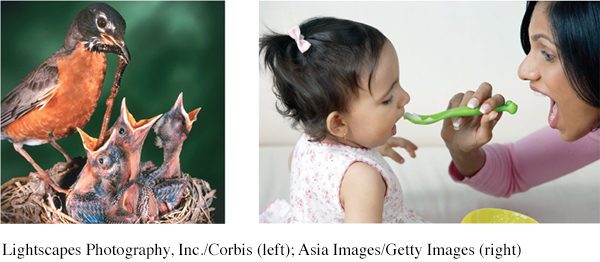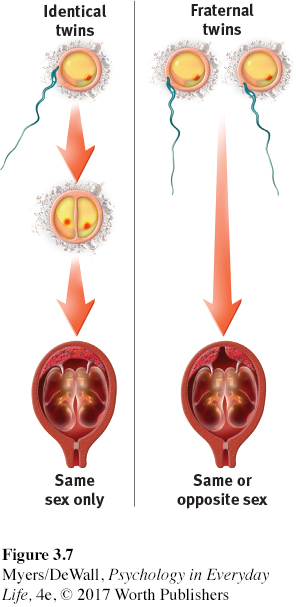3.2 Prenatal Development and the Newborn
Conception
LOQ 3-
Nothing is more natural than a species reproducing itself, yet nothing is more wondrous. For you, the process began when your mother’s ovary released a mature egg—

chromosomes threadlike structures made of DNA molecules that contain the genes.
DNA (deoxyribonucleic acid) a molecule containing the genetic information that makes up the chromosomes.
genes the biochemical units of heredity that make up the chromosomes; segments of DNA.
heredity the genetic transfer of characteristics from parents to offspring.
Contained within the new single cell is a master code. This code will interact with your experience, creating you—

genome the complete instructions for making an organism, consisting of all the genetic material in that organism’s chromosomes.
Genetically speaking, every other human is close to being your identical twin. It is our shared genetic profile—
71
“We share half our genes with the banana.”
Evolutionary biologist Robert May, president of Britain’s Royal Society, 2001
The slight person-

environment every external influence, from prenatal nutrition to social support in later life.
Our human differences are also shaped by our environment—by every external influence, from maternal nutrition while in the womb, to social support while nearing the tomb. Your height, for example, may be influenced by your diet.
interaction the interplay that occurs when the effect of one factor (such as environment) depends on another factor (such as heredity).
How do heredity and environment interact? Let’s imagine two babies with two different sets of genes. Malia is a beautiful child and is also sociable and easygoing. Kalie is plain, shy, and cries constantly. Malia’s pretty, smiling face attracts more affectionate and stimulating care. This in turn helps her develop into an even warmer and more outgoing person. Kalie’s fussiness often leaves her caregivers tired and stressed. As the two children grow older, Malia, the more naturally outgoing child, often seeks activities and friends that increase her social confidence. Shy Kalie has few friends and becomes even more withdrawn. Our genetically influenced traits affect how others respond. And vice versa, our environments trigger gene activity. Nature and nurture interact.

72
epigenetics the study of environmental influences on gene expression that occur without a DNA change.
The field of epigenetics explores the nature–
The molecules that trigger or block genetic expression are called epigenetic marks. When one of these molecules attaches to part of a DNA segment, it instructs the cell to ignore any gene present in that DNA stretch (FIGURE 3.4). Diet, drugs, stress, and other experiences can affect these epigenetic molecules. Thus, from conception onward, heredity and experience dance together.

Retrieve + Remember
Question 3.4
•Put the following cell structures in order from largest to smallest: DNA, chromosome, gene.
ANSWER: chromosome, DNA, gene
Prenatal Development
LOQ 3-
zygote the fertilized egg; it enters a 2-
How many fertilized eggs, called zygotes, survive beyond the first 2 weeks? Fewer than half (Grobstein, 1979; Hall, 2004). For the survivors, one cell becomes two, then four—
embryo the developing human organism from about 2 weeks after fertilization through the second month.
fetus the developing human organism from 9 weeks after conception to birth.
About 10 days after conception, the zygote attaches to the wall of the mother’s uterus. So begins about 37 weeks of the closest human relationship. The tiny clump of cells forms two parts. The inner cells become the embryo (FIGURE 3.5). Many of the outer cells become the placenta, the life-

Prenatal development
| Zygote: | Conception to 2 weeks |
| Embryo: | 2 weeks through 8 weeks |
| Fetus: | 9 weeks to birth |
teratogen [tuh-
Remember: Heredity and environment interact. This is true even in the prenatal period. The placenta not only transfers nutrients and oxygen from mother to fetus, it also screens out many harmful substances. But some slip by. Teratogens, agents such as viruses and drugs, can damage an embryo or fetus. This is one reason pregnant women are advised not to drink alcoholic beverages or smoke cigarettes. A pregnant woman never drinks or smokes alone. When alcohol enters her bloodstream and that of her fetus, it reduces activity in both their central nervous systems.
73
fetal alcohol syndrome (FAS) physical and mental abnormalities in children caused by a pregnant woman’s heavy drinking. In severe cases, signs include a small, out-
Even light drinking or occasional binge drinking can affect the fetal brain (Braun, 1996; Ikonomidou et al., 2000; Marjonen et al., 2015; Sayal et al., 2009). Persistent heavy drinking puts the fetus at risk for birth defects and for future behavior and intelligence problems. For 1 in about 700 children, the effects are visible as fetal alcohol syndrome (FAS), the most serious of all fetal alcohol spectrum disorders, marked by lifelong physical and mental abnormalities (May et al., 2014). The fetal damage may occur because alcohol has an epigenetic effect. It leaves chemical marks on DNA that switch genes to abnormal on or off states (Liu et al., 2009). Smoking during pregnancy also leaves epigenetic scars that weaken infants’ ability to handle stress (Stroud et al., 2014). Some stress in early life prepares us to cope with later adversity. But substantial prenatal stress puts a child at increased risk for later health problems.
 For an interactive review of prenatal development, see LaunchPad’s PsychSim 6: Conception to Birth. LaunchPad also offers the 8-
For an interactive review of prenatal development, see LaunchPad’s PsychSim 6: Conception to Birth. LaunchPad also offers the 8-
Retrieve + Remember
Question 3.5
•The first two weeks of prenatal development is the period of the _______. The period of the _______ lasts from 9 weeks after conception until birth. The time between those two prenatal periods is considered the period of the _______.
ANSWERS: zygote; fetus; embryo
The Competent Newborn
LOQ 3-
reflex a simple, automatic response to a sensory stimulus.
Having survived prenatal hazards, we arrive as newborns with automatic reflex responses ideally suited for our survival. (Recall Chapter 2’s discussion of the neural basis of reflexes.) New parents are often in awe of the finely tuned set of reflexes by which their baby gets food. When something touches their cheek, babies turn toward that touch, open their mouth, and actively root for a nipple. Finding one, they quickly close on it and begin sucking. (Failing to find satisfaction, the hungry baby may cry—

Even as newborns, we search out sights and sounds linked with other humans. We turn our heads in the direction of human voices. We prefer to look at objects 8 to 12 inches away. Wonder of wonders, that just happens to be about the distance between a mother’s eyes and those of her nursing infant (Maurer & Maurer, 1988). We gaze longer at a drawing of a face-

We seem especially tuned in to that human who is our mother. Can newborns distinguish their own mother’s smell in a sea of others? Indeed they can. Within days after birth, our brain has picked up and stored the smell of our mother’s body (MacFarlane, 1978). What’s more, that smell preference lasts. One experiment was able to show this, thanks to some French nursing mothers who had used a chamomile-
So, very young infants are competent. They smell and hear well. They see what they need to see. They are already using their sensory equipment to learn. Guided by biology and experience, those sensory and perceptual abilities will continue to develop steadily over the next months.
74
temperament a person’s characteristic emotional reactivity and intensity.
Yet, as most parents will tell you after having their second child, babies differ. One clear difference is in temperament—whether intense and fidgety, or easygoing and quiet. From the first weeks of life, some babies are irritable, intense, and unpredictable. Others are cheerful and relaxed, with predictable feeding and sleeping schedules (Chess & Thomas, 1987). Temperament is genetically influenced (Picardi et al., 2011; Raby et al., 2012). This effect appears in physical differences: Anxious, inhibited infants have high and variable heart rates. They become very aroused when facing new or strange situations (Kagan & Snidman, 2004; Roque et al., 2012).
Our biologically rooted temperament also helps form our enduring personality (McCrae et al., 2000, 2007; Rothbart, 2007). This effect can be seen in identical twins, who have more similar personalities—
Twin and Adoption Studies
LOQ 3-
For about 1 in 270 sets of parents, pregnancy news brings a bonus. Detection of two heartbeats reveals that the zygote, during its early days of development, has split into two (FIGURE 3.7). If all goes well, some 32 weeks later two genetically identical babies will emerge from their underwater world.

identical (monozygotic) twins twins who develop from a single fertilized egg that splits in two, creating two genetically identical siblings.
fraternal (dizygotic) twins twins who develop from separate fertilized eggs. They are genetically no closer than nontwin brothers and sisters, but they share a prenatal environment.
Identical (monozygotic) twins are nature’s own human clones. They develop from a single fertilized egg, and they share the same genes. They also share the same uterus, and usually the same birth date and cultural history. Fraternal (dizygotic) twins develop from two separate fertilized eggs. As womb-
How might researchers use twins to study the influences of nature and nurture? To do so, they would need to
vary the home environment while controlling heredity.
vary heredity while controlling the home environment.
Happily for our purposes, nature has done this work for us.
 See LaunchPad’s Video: Twin Studies for a helpful tutorial animation.
See LaunchPad’s Video: Twin Studies for a helpful tutorial animation.
Identical Versus Fraternal Twins
Identical twins have identical genes. Do these shared genes mean that identical twins also behave more similarly than fraternal twins (Bouchard, 2004)? Studies of over 14.5 million twin pairs worldwide provide a consistent answer. Identical twins are more similar than fraternal twins in their abilities, personal traits, and interests (Polderman et al., 2015).
Next question: Could shared experiences rather than shared genes explain these similarities? Again, twin studies give some answers.
Separated Twins
On a chilly February morning in 1979, some time after divorcing his first wife, Linda, Jim Lewis awoke next to his second wife, Betty. Determined to make this marriage work, Jim left love notes to Betty around the house. As he lay there he thought about his son, James Alan, and his faithful dog, Toy.
Jim loved his basement woodworking shop where he built furniture, including a white bench circling a tree. Jim also liked to drive his Chevy, watch stock-
What was extraordinary about Jim Lewis, however, was that at that moment (we are not making this up) there was another man named Jim for whom all these things were also true.1 This other Jim—
75
One month later, the brothers became the first of 137 separated twin pairs tested by psychologist Thomas Bouchard and his colleagues (Miller, 2012b). Given tests measuring their personality, intelligence, heart rate, and brain waves, the Jim twins were virtually as alike as the same person tested twice. Their voice patterns were so similar that, hearing a playback of an earlier interview, Jim Springer guessed “That’s me.” Wrong—
This and other research on separated identical twins supports the idea that genes matter.
Twin similarities do not impress Bouchard’s critics, however. If you spent hours with a complete stranger comparing your individual behaviors and life histories, wouldn’t you also discover many coincidental similarities? Moreover, critics note, identical twins share an appearance and the responses it evokes, so they have probably had similar experiences. Bouchard replies that the life choices made by separated fraternal twins are not as dramatically similar as those made by separated identical twins.

Biological Versus Adoptive Relatives
The separated-
How much do adopted children resemble their biological parents, who contributed their genes?
How much do they resemble their adoptive parents, who contribute a home environment?
While sharing a home environment, do adopted siblings also come to share traits?
By providing children with loving, nurturing homes, adoption matters. Yet researchers asking these questions about personality agree on one stunning finding, based on studies of hundreds of adoptive families. Nontwin siblings who grow up together, whether biologically related or not, do not much resemble one another in personality (McGue & Bouchard, 1998; Plomin et al., 1988; Rowe, 1990). In traits such as outgoingness and agreeableness, people who have been adopted are more similar to their biological parents than to their caregiving adoptive parents.
As we discuss throughout this book, twin and adoption study results shed light on how nature and nurture interact to influence intelligence, disordered behavior, and many other traits.
Retrieve + Remember
Question 3.6
•How do researchers use twin and adoption studies to learn about psychological principles?
ANSWER: Researchers use twin and adoption studies to understand how much variation among individuals is due to heredity and how much to environmental factors. Some studies compare the traits and behaviors of identical twins (same genes) and fraternal twins (different genes, as in any two siblings). They also compare adopted children with their adoptive and biological parents. Some studies compare traits and behaviors of twins raised together or separately.